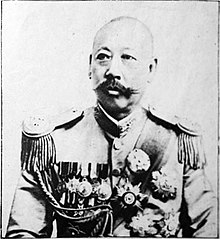| This article includes a list of references, related reading, or external links, but its sources remain unclear because it lacks inline citations. Please help improve this article by introducing more precise citations. (May 2024) (Learn how and when to remove this message) |
| Zhili clique | |
|---|---|
| 直隸系軍閥 | |
 The Peiyang Star, which was derived from the five-coloured flag of the Republic of China The Peiyang Star, which was derived from the five-coloured flag of the Republic of China | |
| Active | 1920–1928 |
| Country | |
| Allegiance | Beiyang government |
| Type | Warlord faction |
| Engagements | |
| Commanders | |
| President | Feng Guozhang, Cao Kun |
The Zhili clique (Chinese: 直隸系軍閥; pinyin: Zhílì xì jūnfá) was a military faction that split from the Republic of China's Beiyang Army during the country's Warlord Era. It was named for Zhili Province (modern-day Hebei), which was the clique's base of power. At its height, it also controlled Jiangsu, Jiangxi, and Hubei.
The Beiyang Army fragmented following the death of Yuan Shikai, who had been the only person keeping regional factions from contesting territory throughout China. Unlike other cliques, Zhili was formed by army officers, who felt they had been snubbed by Premier Duan Qirui regarding appointments and promotions. These officers rallied around President Feng Guozhang, who had to share power with Duan's dominant Anhui clique in the Beiyang government. Lacking strong bonds, they were more willing to abandon or betray one another.

They advocated a softer line during the Constitutional Protection War. After Feng's natural death, leadership passed to Cao Kun. Cao was victorious in the Zhili–Anhui War (1920) though the credit belongs to his chief lieutenant, Wu Peifu, who was considered as one of the greatest strategists in China at the time. Relations with the Fengtian clique, which gave nominal assistance against Anhui clique, deteriorated and Wu again brought victory during the First Zhili–Fengtian War (1922). In the next two years, the Zhili clique scored successive victories which led to Cao Kun's ascendancy to the presidency via bribery. Cao's ambition brought all of his enemies against him and created dissent within the clique. Zhili might have won the Second Zhili–Fengtian War (1924) and eventually reunite all of China had it not been for Feng Yuxiang's betrayal with the Beijing Coup. Cao was imprisoned and leadership passed to Wu who along with Sun Chuanfang managed to hold central China for the next two years. During the Kuomintang's Northern Expedition, they created a desperate alliance with their former Fengtian enemies but were defeated entirely. The Zhili clique was the only warlord faction to be destroyed as a result of the Northern Expedition.
They were also strongly anti-Japanese. Western powers were sympathetic but provided no support with the exception of foreign private businesses who appreciated their adoption of an anti-communist and anti-union stance in 1923. Wu Peifu had initially invited the Chinese Communist Party to end the Communications Clique's stranglehold over the railways but found the Communists to be a greater threat and put them down with violence.
See also
- List of warlords and military cliques in the Warlord Era
- History of the Republic of China
- Seo Wal-bo (an air brigade commander under the Zhili)
References
- Nathan, Andrew (1998). Peking Politics 1918–1923: Factionalism and the Failure of Constitutionalism. Center for Chinese Studies. p. 320. ISBN 9780892641314.
- Wou, Odorik Y. K. (1978). Militarism in modern China. The career of Wu P'ei-Fu, 1916–1939. Australian National University Press. p. 349. ISBN 0708108326.
- Gao, James. Historical Dictionary of Modern China (1800–1949).
This article related to the history of China is a stub. You can help Misplaced Pages by expanding it. |